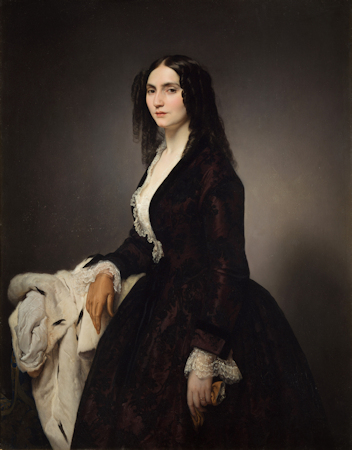The Wiener Moderne is the poster child for Viennese culture. But other eras brought forth powerful and influential art, as the Biedermeier exhibition at the Leopold Museum reveals.
- The art and artists of the years 1815-1848
- Also placed into their cultural context and role in art history
- Wider geographical remit than just Vienna
- Runs April 10 – July 27, 2025
- Book tickets* for the Leopold Museum
- See also:
The Rise of an Era

(Francesco Hayez, Portrait of the Singer Matilde Juva Branca, 1851; © Galleria d’Arte Moderna, Milan; photo: Comune di Milano – all rights reserved – Galleria d’Arte Moderna, Milan)
Look for exhibitions on the “Georgian” and “Victorian” era in Vienna and you’ll be as disappointed as a ball-going cavalry officer with an empty dance card. Largely because no rulers here bore the name George or Victoria.
But the Habsburg-run empire had its own cultural periods. And one of the more important ones was the Biedermeier, which ran from 1815 to 1848…from the end of Napoleonic conflict to the year of revolution.
As the same-named exhibition at the Leopold Museum shows, the era proved a pivotal one in art history.
As well as introducing period art, the Biedermeier exhibition demonstrates how this art was a child of the times. But also how it prepared the way for what came later. No man is an island, and few artists are, either.

(Ferdinand Georg Waldmüller, Restored to New Life, 1852; photo by and © LIECHTENSTEIN. The Princely Collections, Vaduz–Vienna)
The first half of the 19th century saw the growth of a well-to-do middle class, so commissioned art and collecting art expanded well beyond the realms of the aristocracy.
Artists shifted to reflect the new circumstances, for example by reducing canvas sizes to fit smaller walls.
Almost paradoxically, the wish to demonstrate position and achievement within your portrait, despite the lack of an estate or title, led to more realistic painting approaches. And this seeped into other genres: realism in how something is painted but also realism in the choice of what to portray.
A conservatism encouraged by a heavy-handed state machinery would not normally inspire radical creativity. But the retreat into home comforts also gave rise to, for example, a focus on simplicity, beauty and quality in furnishings that would later influence modernist designers.
The Leopold Museum’s exhibition enlightens us on such issues. However, it takes a less Vienna-centric approach than is usual with events around the Biedermeier. After all, the empire at times included such cities as Venice, Prague, Milan and Ljubljana.

(Angelo Inganni, View of the Piazza del Duomo with the Coperto dei Figini, 1838 © Milano, Palazzo Morando | Costume Moda Immagine; photo: Comune di Milano – Tutti i diritti riservati – Palazzo Morando | Costume Moda Immagine, Milano (in deposito dall’Archivio Storico Civico e Biblioteca Trivulziana, Milano)
The works on display illustrate the characteristic trends and developments of the time.
So expect to see portraits that double as high-end statements of fashion and status. But also portraits that bear the legacy of realism, such as the inevitability of old age.
Expect, also, to see landscapes and travel scenes from across the empire and beyond, often reflecting the genuine beauty in the geographical jewels in the imperial crown. Now a small republic, Austria still retains a natural charm formed from mountains, lakes, and forests.
I’ll add more details once I’ve had a chance to visit.
Dates, tickets & tips
Immerse yourself in the first half of the 1800s from April 10th to July 27th, 2025. An entrance ticket for or from the Leopold Museum includes the exhibition.
(Booking service provided by Tiqets.com*, who I am an affiliate of)
I have a whole article introducing the Biedermeier, which also contains suggested museums and preserved buildings from that time, should you wish to learn more.
How to get to the 1800s
Find your way to the museum using the travel tips on the overview page, then drop down to level -2 when inside.
Address: Museumsplatz 1, 1070 Vienna
